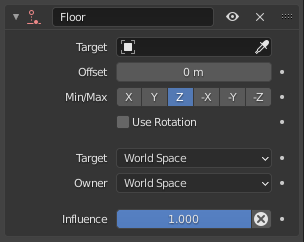Restricción Piso
The Floor constraint allows you to use its target position (and optionally rotation) to specify a plane with a «forbidden side», where the owner cannot go. This plane can have any orientation you like. In other words, it creates a floor (or a ceiling, or a wall)! Note that it is only capable of simulating entirely flat planes, even if you use the Vertex Group option. It cannot be used for uneven floors or walls.
Opciones

El panel Piso.
- Destino
ID de datos used to select the constraints target, and is not functional (red state) when it has none. See common constraint properties for more information.
- Desplazamiento
Allows you to offset the «floor» plane from the target’s origin, by the given number of units. Use it e.g. to account for the distance from a foot bone to the surface of the foot’s mesh.
- Máx/Mín
Controls which plane will be the «floor». The names of the buttons correspond, indeed, to the normal to this plane (e.g. enabling Z means «XY plane», etc.). By default, these normals are aligned with the global axes. However, if you enable Use Rotation (see above), they will be aligned with the local target’s axes. As the constraint does not only define an uncrossable plane, but also a side of it which is forbidden to the owner, you can choose which side by enabling either the positive or negative normal axis… e.g. by default Z, the owner is stuck in the positive Z coordinates.
- Usar rotación
Forces the constraint to take the target’s rotation into account. This allows you to have a «floor» plane of any orientation you like, not just the global XY, XZ and YZ ones…
- Objetivo / Propietario
Standard conversion between spaces. See common constraint properties for more information.
- Influencia
Controla el porcentaje de efecto que la restricción ejercerá sobre el objeto. Ver propiedades comunes de restricciones para más información.